The College of Missions (Danish : Missionskollegiet; Latin : Collegium de cursu Evangelii promovendo) or Royal Mission College (Kongelige Missions-Kollegium) was a Dano-Norwegian association based in Copenhagen which funded and directed Protestant missions under royal patronage. Along with the Moravian church, it was the first large-scale Protestant mission effort.
The college was established by Frederick IV in 1714 to institutionalise the work he began by funding Bartholomäus Ziegenbalg and Heinrich Pluetschau's mission at the Danish colony of Fort Dansborg (Tranquebar) in India. Among its first efforts were funding missions in Lapland and Hans Egede's Bergen Greenland Company, which established the Island of Hope mission in 1721. Two child converts from the mission would later inspire Count von Zinzendorf to begin the Moravian missions.
Its first chairman (præses) was Johan Georg von Holstein (16 February 1662 – 26 December 1730), [1] who was the namesake for Holsteinsborg (now Sisimiut) in Greenland. [2]
Work among the Sami (Finnemisjon) was initiated under the pietist Thomas von Westen (1682–1727) in 1716. He swiftly established thirteen stations before his death. [3]
Work in Greenland was directed first by Hans Egede and then, after the death of his wife, his son Paul. It was administered in conjunction with the Moravian missions there and the various chartered companies, particularly the Royal Greenland Trading Department. Early on, the well-endowed college could provide an extensive scientific library to missionaries like Hans Glahn, Otto Fabricius, and Andreas Ginge who studied the flora, fauna, and meteorology of Greenland during their missions. [2] Money was so limited in the later 18th century that all but five missionaries were returned to Denmark in 1792 and British hostility during the Napoleonic Wars brought the number down to a single person. [4]
Most of the college's early records were destroyed in a Copenhagen fire between 5 and 7 June 1795. [2] The college was closed down on 17 June 1859 by Frederik VII [5] and its remaining activities were transferred to the Ministry of Culture. [6]
As of the royal decree of 19 April 1715, the College of Missions was also the main organisation for missions work among the Sami in Norway. For the first ten to twelve years, the work was led by Thomas von Westen.
The College of Missions received a royal allocation of 2000 rigsdaler; in addition, the college was allowed to take over the 1000 rigsdaler the churches in Finnmark had in capital. Additionally, it was determined in 1716–1718 that all main churches in the country would give two rigsdaler yearly to the missions work in Finnmark; annex churches would give one. Furthermore, the income of the churches in Helgeland would also go towards the mission. In 1720 the income from the churches in Vesterålen, Salten, and Lofoten was added to the mission. The most important source of the churches' income came from the construction of farms the churches owned in the district.
After the College of Missions was subordinated to the chancery, the properties the churches owned were transferred to the Nordland Church and School Fund .
The College of Missions employed missionaries and teachers, and operated schools and churches in Sami areas.
Norway was split into thirteen missionary districts, at the most:

Denmark and the former real union of Denmark–Norway had a colonial empire from the 17th through to the 20th centuries, large portions of which were found in the Americas. Denmark and Norway in one form or another also maintained land claims in Greenland since the 13th century, the former up through the twenty-first century.

Nuuk is the capital of and most populous city in Greenland, an autonomous territory in the Kingdom of Denmark. Nuuk is the seat of government and the territory's largest cultural and economic center. Nuuk is also the seat of government for the Sermersooq municipality. In January 2024, it had a population of 19,872, - more than a third of the country’s population - making it one of the smallest capital cities in the world by population. Nuuk is considered a modernized city after the policy began in 1950.

Hans Poulsen Egede was a Dano-Norwegian Lutheran missionary who launched mission efforts to Greenland, which led him to be styled the Apostle of Greenland. He established a successful mission among the Inuit and is credited with revitalizing Dano-Norwegian interest in the island after contact had been broken for about 300 years. He founded Greenland's capital Godthåb, now known as Nuuk.
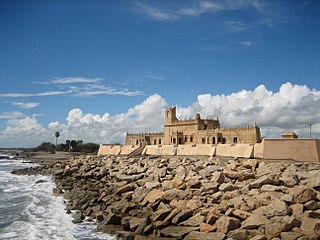
Tharangambadi, formerly Tranquebar, is a town in the Mayiladuthurai district of the Indian state of Tamil Nadu on the Coromandel Coast. It lies 15 kilometres (9.3 mi) north of Karaikal, near the mouth of a distributary named Uppanar of the Kaveri River. Tranquebar was established on 19 November 1620 as the first Danish trading post in India. King Christian IV had sent his envoy Ove Gjedde who established contact with Raghunatha Nayak of Tanjore. An annual tribute was paid by the Danes to the Rajah of Tanjore until the colony of Tranquebar was sold to the British East India Company in 1845.
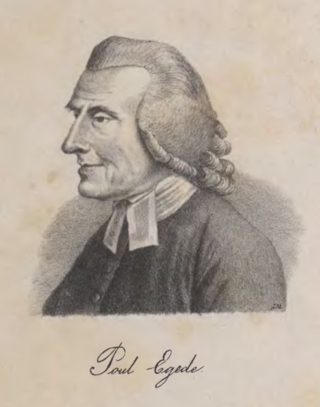
Paul or Poul Hansen Egede was a Dano-Norwegian theologian, missionary, and scholar who was principally concerned with the Lutheran mission among the Kalaallit people in Greenland that had been established by his father, Hans, in 1721.
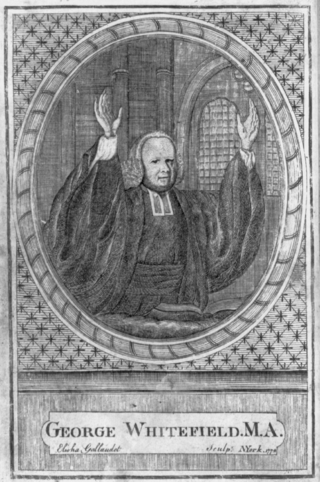
Christianity in the 18th century is marked by the First Great Awakening in the Americas, along with the expansion of the Spanish and Portuguese empires around the world, which helped to spread Catholicism.
Arnarsaq, was an Inuk translator, interpreter, and Christian convert who lived in what is now modern-day Greenland. She is particularly known for her work with the Danish theologian Paul Egede. Alongside Hans Punngujooq, Arnarsaq helped Egede translate the New Testament into Greenlandic. She had an important position in the Danish missions among the Inuit on Greenland in the 18th century, and has also been portrayed in fiction.

Peder Olsen Walløe was a Danish Arctic explorer most noted for his historic exploration of the former Norse settlements on Greenland.
Jacob Sørensen Severin was a Danish merchant who held a trade monopoly on Greenland from 1733 to 1749.
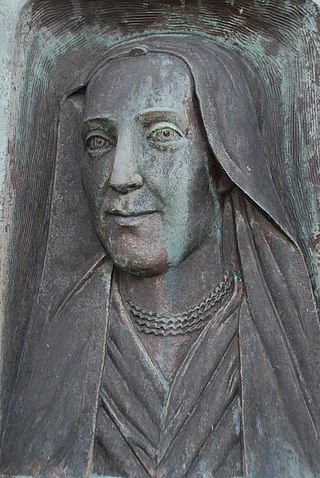
Gertrud Rask was the first wife of the Danish-Norwegian missionary to Greenland Hans Egede and was the mother of the missionary and translator Paul Egede.

Old Nuuk may refer to several neighborhoods of Nuuk, the capital of Greenland.
Hans Egede Saabye was a Danish priest and a missionary to Greenland.
The Moravian missions in Greenland were established by the Moravian Church or United Brethren and operated between 1733 and 1900. They were operated under the auspices of the Royal Danish College of Missions until its dissolution in 1859 and were finally surrendered to the Lutheran Church of Denmark in 1900. Missionaries were allocated to the region and sometimes even sent wives who had been chosen for them and approved by the drawing of lots, a form of Cleromancy.
The Bergen Greenland Company or Bergen Company (Bergenkompagniet) was a Dano-Norwegian private corporation charged with founding and administering Danish-Norwegian colonies and trade in Greenland, as well as searching for any survivors from the former Norse settlements on the island. It operated from 1721 until its bankruptcy in 1727. Although the Bergen Company failed as a concern and both its settlements were destroyed and abandoned, it was ultimately successful in re-establishing sovereignty over Greenland.
Hartvig Hansen Jentoft was a Norwegian tradesman and sailor.

Thomas von Westen was a Norwegian Lutheran priest and missionary. He was a driving force in the Sami mission, and founded the education institution Seminarium Scholasticum, the later Seminarium Lapponicum, in Trondheim.

The Nærøy manuscript, originally Relation anlangende Find-Lappernis saa-vel i Norrlandene og Finmarken som udi Nummedalen, Snaasen og Selbye deres Afguderie og’ Satans Dyrkelse, som Tid efter anden ere blevne udforskede og decouvrerede [Treatise on the Sami in Nordland and Finnmark as well as in Namdal, Snåsa and Selbu, their idolatry and worship of Satan, as it has been revealed], is a 1723 treatise by Johan Randulf, then a vicar in Nærøy. Randulf writes about Sami missionary Thomas von Westen's visit to Nærøy in January 1723. Randulf and von Westen summoned the Sami people of the parish to be interviewed and taught at the vicarage of Nærøy Church.

The New Jerusalem Church was built in 1718 by the Royal Danish missionary Bartholomaeus Ziegenbalg in the coastal town of Tranquebar, India, which was at that time a Danish India colony. The church is located on King Street, and church services are conducted every Sunday. The church, along with other buildings of the Tranquebar Mission, was damaged during the tsunami of 2004, and were renovated at a cost of INR 7 million, and re-consecrated in 2006.

The Tranquebar Mission was established in 1706 by two German missionaries from Halle namely, Bartholomäus Ziegenbalg and Heinrich Plütschau. Ziegenbalg and Plütschau responded to the appeal of King Frederick IV of Denmark to establish a mission for the natives, living in the Danish East India Company colony of Tranquebar. The mission was responsible for the printing and publication of the Bible in the Tamil language. In 2006, the 300 years anniversary of the mission was celebrated by the Tamil Evangelical Lutheran Church (TELC), with many international delegates in attendance. A monument to acknowledge 300 years of the mission was raised by the TELC on this occasion.
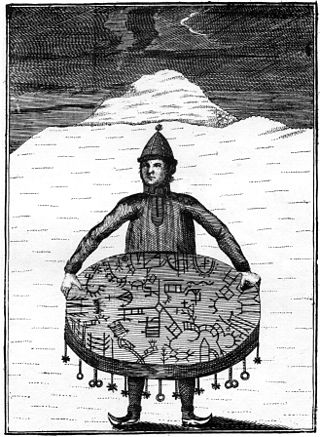
The Christianization of the Sámi people in Norway, Sweden, and Finland took place in stages during a several centuries-long process. The Sámi were Christianized in a similar way in Norway, Sweden, and Finland.